ESG / CSR
Industries
Is Venice Threatened by Climate Change or Tourism?
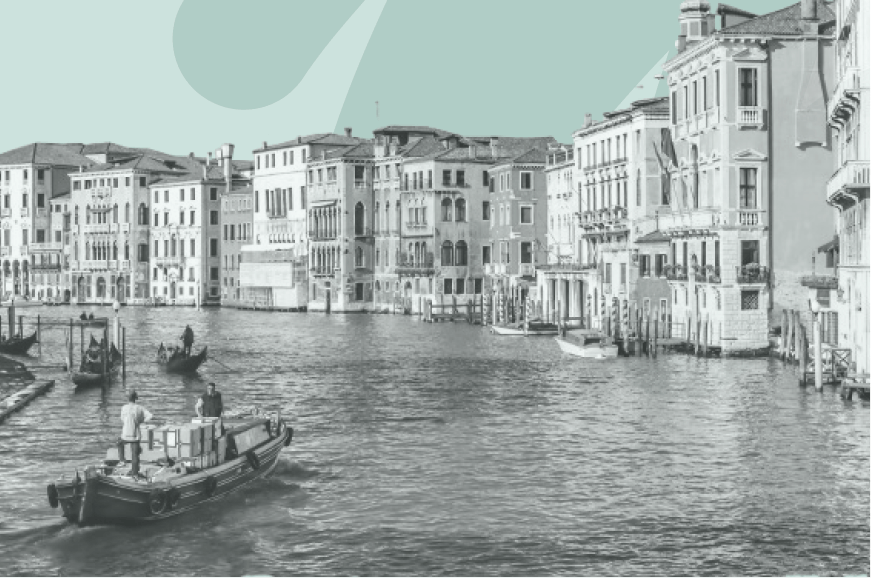


- The importance of Venice to Italy and tourism
- The profound impact of climate change on Venice
- Potential solutions to mitigate causing further harm to Venice
Venice is one of the most desired tourist destinations in Italy: known for its charming waterways, macaroon-decorated scoops of gelato, and infamous water taxis – but is it possible to save Venice in the midst of rising water in the sinking city?
With an estimated 30 million annual visitors, Venice remains as one of the most desirable cities to visit in the world – making it a valid question to wonder if Venice will start to struggle with tourism as climate change continues to progress.
Despite extreme events such as coastal flooding and monumental sea level rise, the Venice City Council voted back in 2019 against a climate crisis plan in the case of extreme weather events – but surely, as the historic city finds itself experiencing the worst floods it has half a century, the Italian government may regret its previous choices.
In this article, we’ll explore why is Venice sinking, how Venice might be threatened by climate change, why its tourism could suffer from – and why both of these interrelated negative impacts could harm Italy as a whole.
What Attracts Tourists to Venice?
Italy as a whole attracts tourists from all over the world, welcoming a whopping 20 million tourists in 2023 alone – with that number expected to grow as the global economy continues to heal following the pandemic.
Some of Italy’s most visited cities include Rome, Milan, and Florence – but Venice stands out from the rest due to the fact the city is situated almost entirely on water.
In fact, to get around Venice, a water taxi, elevated wooden walkways, or gondola ride may be necessary. The interactive flips cards below (move cursor over card to flip) will reveal how tourists and locals alike get around Venice as the city sinks:
What is Venice, Italy Known For?
Venice, a city with deep history residing in Northern Italy, is commonly referred to as a romantic city nestled on the water, Venice is most known for its gondala rides and iconic Venitian landmarks rides.
The summary cards below will reveal some of the most popular things and neighborhoods to see in Venice:
🛶 Gondola Ride
Float through narrow canals with iconic views of Venice—but be warned, the gentle rocking may leave you dizzy!
🍦 Eat Gelato
Cool off with artisanal gelato while wandering the piazzas—try classic flavours like pistachio or hazelnut.
🥐 French Touch
Notice the subtle French influence with macaroons and architecture—a unique contrast to the rest of Italy.
🚤 Speed Boat Tour
Hop on a water taxi or boat tour to circle the city and see major landmarks like the Rialto Bridge from the water.
🏛️ St. Mark’s Tower
Climb or take the lift up St. Mark’s Campanile for sweeping views over Venice’s red rooftops and winding canals.
🍝 Try Venetian Cuisine
Sample traditional dishes like sarde in saor (sweet & sour sardines) or risotto al nero di seppia (squid ink risotto).
Landmarks in the Historical City
Home to beautiful sights such as Saint Mark’s Square and the Rialto bridge, Venice’s unique charm is alluring to many tourists for its romance, scenic sunsets, picturesque setting, architecture, and Venezian culture.
Additional tourist attractions in Venice besides St. Mark's Square and the surrounding Venetian Lagoon include:
🛶 Grand Canal
Take in the city's heart from a vaporetto or gondola as you glide past elegant palazzi and historic bridges.
🏰 Piazza San Marco
Admire Venice’s grandest square—home to St. Mark’s Basilica, the Campanile, and flocks of curious pigeons.
📚 Cultural Heritage
Learn how Venice preserved its identity for centuries—from unique dialects to glass-blowing traditions.
🏛️ Historic Center
Wander the labyrinth of alleyways and bridges that make up the UNESCO-listed core of Venice.
However, one of the most distinctive features of Venice (the fact that it is made up of 118 islands and requires residents and travelers alike to use water transportation) may also be the very thing that brings Venice to meet its doom.
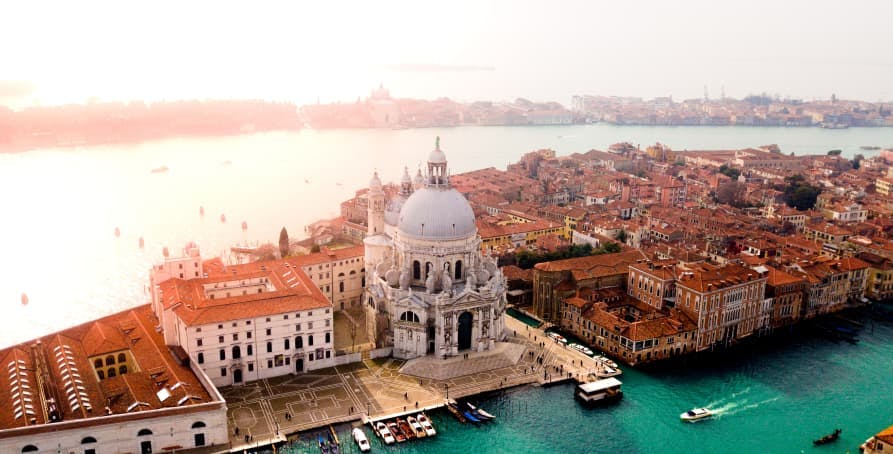
What is Happening in Venice Right Now in 2025?
Venice isn’t the city it was a few years ago, as in 2025 – Venice is finally suffering the effects of climate change due to unforeseen flooding.
Flooding is not atypical in Venice, as the city has been dealing with flooding for hundreds of years – meaning the rise in water levels have occurred as a result of both natural and human-based activity reasons.
Venice: A Floating City with High Tides in 2025
In fact, as of 2025 – Venice has developed an extensive plan to raise the entire city above water as Venice is sinking. This plan includes foregoing the existing wooden piles that have been holding up the city for years in exchange for barriers to block the hide tides from entering the city's waterways at all. This would require pumping water into the Earth far below Venice itself to raise the seabed, and ultimately – Venice.
An associate professor in hydrology and hydraulic engineering at the nearby University of Padua, Pietro Teatini, claims that this could help Venice to buy time to develop a more long term project for the development and construction of a solution that would last for decades and help ensure that Venice continues to attract tourists from around the world.
The vertical timeline below will break down how Pietro Teatini's proposed planned could help the high water currently suffocating the city of Venice sinking:
-
1. Identify the Problem 🌊
Venice is sinking ~2 mm per year. Rising sea levels and worsening floods threaten its future.
-
2. Study the Sediment Layers 🧪
Scientists analyzed deep lagoon clays to explore how freshwater injection could impact elevation.
-
3. Inject Freshwater into Clay 💧
Introducing freshwater expands compacted clay layers below the surface, slowly lifting the city.
-
4. Target Deep Aquifers 📍
Water is pumped into layers 600m deep, creating gradual and even elevation — without damaging buildings.
-
5. Gradual Elevation Gain ⬆️
The technique could raise Venice by 30 cm over 30 years — offsetting sea level rise.
-
6. Works with MOSE System 🛡️
This long-term strategy complements the MOSE flood barriers, creating dual protection.
-
7. A Sustainable Future 🌿
The project could help Venice rise — literally — without harming infrastructure or heritage.
How Does Venice Usually Deal with Storm Surges Near the Adriatic Sea?
Usually, the season where tides in Venice are the highest is referred to as “acqua alta” – and lasts from fall through winter. This is imperative, as fall through winter is considered shoulder season for tourists in Venice – meaning the flood levels have usually been obsolete during peak tourist season (May to August).
In fact, back in August 2023 – Venice was experiencing flooding earlier than it usually would, leaving tourists left to wander around famous landmarks such as Saint Mark’s Square with water halfway up to their knees.
Impact of Acqua Alta on Venice Sinking
As a whole, the reason why Acqua Alta has an effect on Venice sinking is because it accelerates the already weakening foundation and overwhelming drainage systems in the city – all of which continue to deteoriate.
In fact, Acqua Alta could be a consequence of poorly managing the surrounding lagoon – deepening underwater channels to make way for tankers.
Reminder: Why is Venice Sinking?
Venice is sinking as a result from groundwater extraction, heavy buildings, the shifting Adriatic plate beneath the Apennine Mountains, rising sea levels, and more – meaning that the continuous flooding from acqua alta high tides all exacerbate the already fragile conditions of the city
The summary cards below will further depict how acqua alta and Venice sinking have an impact not only on the city of Venice itself, but Italy as a country – as the lack of tourism in Venice could cause financial repercussions for the entire country.
🇮🇹🛶 Venice
Flooding and sinking landmarks are driving tourists away from Venice — a city that heavily depends on tourism for its survival, with over 20 million visitors annually.
🇮🇹💶 National Revenue
Tourism in Venice contributes significantly to Italy’s GDP. A steep drop in visitors could ripple across hospitality, transit, and local businesses nationwide.
🧑🍳 Local Employment
With fewer tourists, jobs in hotels, restaurants, museums, and guided tours are at risk — putting economic pressure on Venetians and surrounding towns.
🏛️ Government Burden
The Italian government may face growing costs for climate infrastructure and economic support, especially if Venice continues to lose its tourism appeal.
Efforts to Save Venice: The Sinking City
In fact, after centuries of well-known landmarks in Venice withstanding the extreme floods, some architectural treasures have finally let the water damage get the best of them – such as with Saint Mark’s Basilica. This iconic monument in Venice is set to undergo a €3.3 million restoration to help restore it to its original condition before flooding became the issue it is today.
The initiative to restore Saint Mark’s Basilica is a significant sign that flooding and water damage is becoming a serious issue in Venice – seeing as the famous landmark has withstood almost 1000 years of high tides before.
Flooding is common in Venice, but it has never occurred on this scale during the high tourist season before. August is the peak season for both Europeans and Americans traveling to Italy, and high tides like these could prevent tourists from wanting to return in the coming years.
In fact, new Italian scientists have concluded that as a result of global warming, Venice's buildings and the entire city itself will be underwater by 2150.
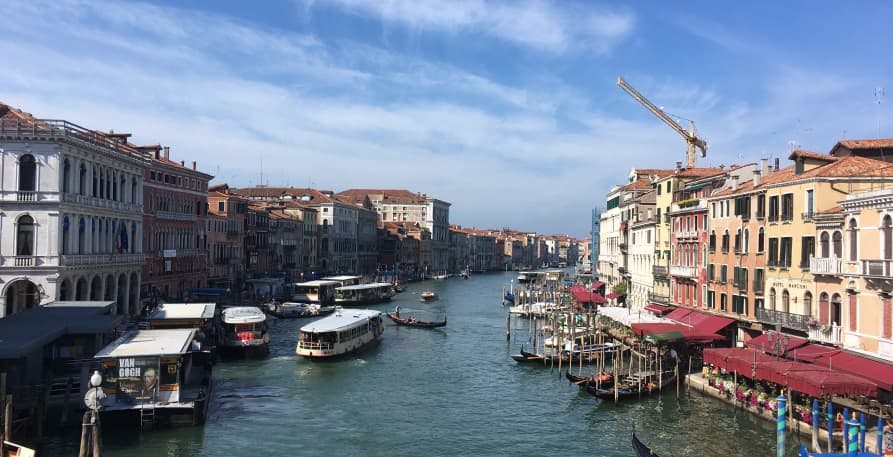
How Could Climate Change Threaten Venice?
Even if the majority of Venetians are used to periodic rising tide levels, tourists are not used to the numerous delays or how waters rise in Venice – meaning both visitors and those who live in Venice are realizing what climate change could do to this beloved city.
Climate change could continue to make flooding worse, seeing as much of the high tides occurring in Venice actually starts with warm, strong winds from the Mediterranean and Northern Africa – something that is bound to only get worse as climate change continues to evolve. This in combination with global rising sea levels and melting polar ice caps means that tides in Venice aren’t going to get better on their own.
Why Does the Historic City Need a Plan Against Rising Sea Levels?
The entire city of Venice needs a plan against rising sea levels as the conditions causing Venice to sink are only getting worse over time.
In fact, if a plan to protect Venice from high tides isn’t developed, it could result in the entire city of Venice sinking one day – much like New York City as Venice’s ground level has been sinking by 1 millimeter each year.
Venice Is Sinking: Consequences if No Action Is Taken
If circumstances continue as they currently are, climate change could cause Venice to be up to 6 feet underwater by the end of the century in addition to historic landmarks being destroyed due to water damage.
Ultimately, climate change could make flooding in Venice worse, more common, and occur more frequently during high tourist season – all of which could cause the entire country of Italy enormous financial stress.
The drop down sections below will further break down how climate change will make flooding in Venice worse: (use keywords like about the same rate, low pressure, fossil fuels, and combined)
🌡️ Warmer Temperatures = More Floods
As the climate warms, water expands and glaciers melt—raising sea levels at about the same rate that Venice is sinking.
🌬️ More Low-Pressure Systems
Climate change increases low-pressure weather systems over the Adriatic, which trap water in the Venetian Lagoon and raise flood levels.
🔥 Fossil Fuels Driving Acqua Alta
Burning fossil fuels releases greenhouse gases that trap heat and warm the oceans—making seasonal flooding like acqua alta more severe.
💧 Combined Effects = Crisis
Venice is facing the combined effects of subsidence, rising seas, and storm surges—making flooding worse and more frequent each year.
Why Fighting Against Flooding is Especially Important for Italy and Venice
Italy, much like other Southern European countries such as Greece, Portugal, and Spain, depends on tourism in order for the country to thrive. In fact, tourism is imperative to a country like Italy – seeing as it is responsible for 14% of the country’s GDP. If high tides were to occur during peak tourist season, Venice could see a decrease in tourism, and could depress not only Venice’s economy – but all of Italy.
Many Venetians work in restaurants, hospitality services, or water transportation that all thrives in the midst of peak tourist season.
In fact, tourism in Italy has provided 6.1% of all jobs for the country. If high tides continue and push tourists away, less Italians able to work during high tourist season could lead to unemployment and more economic issues for Venice and Italy.
The table below will further depict how climate change will have a profound impact on Venice:
| Aspect | Impact |
|---|---|
| 🧑🌾 Seasonal Employees |
|
| 🧳 Tourists |
|
| 🏛️ Historic Landmarks |
|
| 🏪 Local Businesses |
|
| 🏠 Residents |
|

How Likely is Climate Change to Influence Tourism in Venice?
Let’s face it – a romantic getaway or family vacation doesn’t usually include needing to wear rubberized shoes or sloshing around in high tide water where idiosyncratic European cobblestone streets should be.
Most tourists come to Venice to devour Italian cuisine, take a Gondola ride, and walk many of the city’s marvelous bridges. Even those with the most ravenous appetites for adventure probably prefer to take pictures of Saint Mark’s Square without having to wear water shoes.
Much of the charm of Venice could also be gone if the entire city is to be flooded with water. The magic of a gondola right could become underwhelming due to immense flooding – as transporting via water would become a necessity everywhere in Venice, something that may grow tedious to tourists trying to get from one point to another.

Sea Level Rise Could Deter Tourists From Visiting Venice
Climate change could have a devastating profound influence on tourism in Venice, as the increased flooding is bound to make future trips to Venice uncomfortable and unpleasurable, and may result in a lot of tourists traveling to Italy to skip over Venice in the future – which could harm Italy’s GDP seeing as Venice is the country’s third most visited city.
In fact, St. Mark’s Basin, the main square in Venice, could be wiped out by 2050. This is one of Venice's most iconic and beautiful spots to visit: filled with photo opportunities, a trip to the top of Saint Mark’s Campanile (a bell tower with sweeping views of the city), tourist stands, souvenir shops, and restaurants – all of which could cease to exist as the plaza is threatened by climate change.
How Can Venice Adapt to Become More Resilient to the Effects of Climate Change?
Climate change may be in full swing, but Venice’s efforts to fight against the impact that climate change has had on its city could still be kicked up a notch.
There is still a lot that Venice could do to prevent flooding from getting as bad as it has in recent years.
Here are just some of the ways that Venice is working to protect its historic buildings, coastal zones, urban fabric, and Venice's lagoon from natural hazards.
Banning Cruise Ships to Deter Tourists
Venice alone attracts 30 million annual visitors alone, with many of those tourists visiting the Venice Lagoon and Northern Adriatic Sea for the day alone. In fact, the city attempted to place a 5€ entry fee to reduce the amount of tourists frolicking to lagoon Venice – but it was proven unsuccessful.
Despite the fact that Venice has a unique layout, climate scientists have been working with local officials for years to ensure that rising sea levels don’t impact Venice more than they already have – such as by banning cruise ships from docking in Venice.
Mobile Barriers in the Event of Storm Surges
Other ways to combat high tides due to climate change could include implementing moveable barriers underwater or installing shields for iconic landmarks in Venice: such as Saint Mark’s Square and Doge's Palace. In fact, renovations to install such a barrier in Venice have already taken place in Saint Mark’s Square – costing the city €5.3 million to install and could be even more expensive as further plans to protect Venice develop.
Avoiding the Climate Crisis and Protect the Sea Floor with the MOSE Project
Another effort on behalf of the Roman Government was MOSE, or Modulo Spertimentable Electtromeccanico (Electromechanical Experimental Module in English) – which is a €6 billion euro barrier system that was implemented to help prevent massive waves from pushing the tide level higher. Venice has still suffered from high tides, but MOSE has helped to decrease the severity of the impact rising sea levels have had on Venice.
Did you know that MOSE indirectly refers to “Moses” – nicknaming the barrier after the figure who parted the seas in biblical times.
Despite the benefits of MOSE so far, more needs to be done – as many scientists have raised concerns over the fact that the barriers may prevent the lagoon water found in the canals of Venice from vital sediments that the marshes may need to survive. Other efforts Venice has taken to help mitigate the effect of climate change include banning cars from driving in the historic parts of Venice.
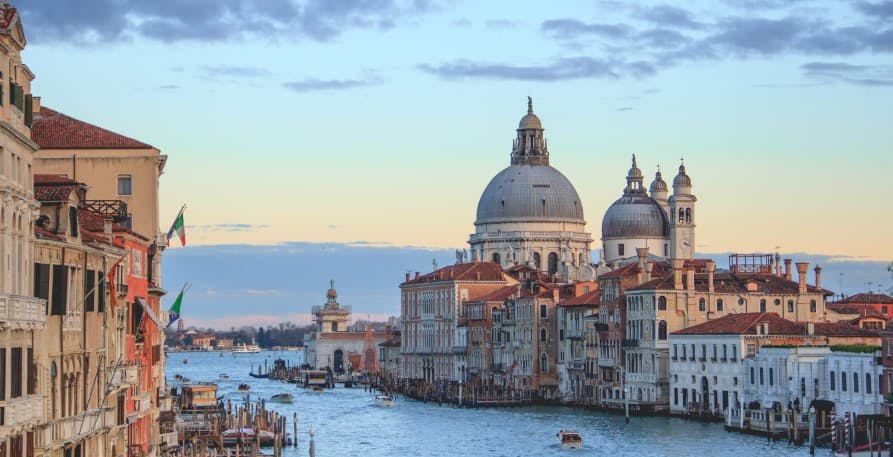
Ultimately, Venice is actively doing its best to adapt in the midst of climate change – from local governments to Venetians themselves supporting new developments to keep high tides out of Venice.
In addition to this, Travelers can do a lot to help support Venice in the midst of climate change, too. Tourists can help to support the domestic economy by booking independently owned hotels, Venetian-run restaurants as opposed to tourist traps, and going to lesser known (but still cool!) areas in the city such as the Jewish Ghetto or Campo San Maurizio.
Climate change is inevitably catching up to Venice, and now – is up to the city, its residents, and the millions of people who travel there each year to step up and share their support to make sure Venice will still be here for centuries to come.
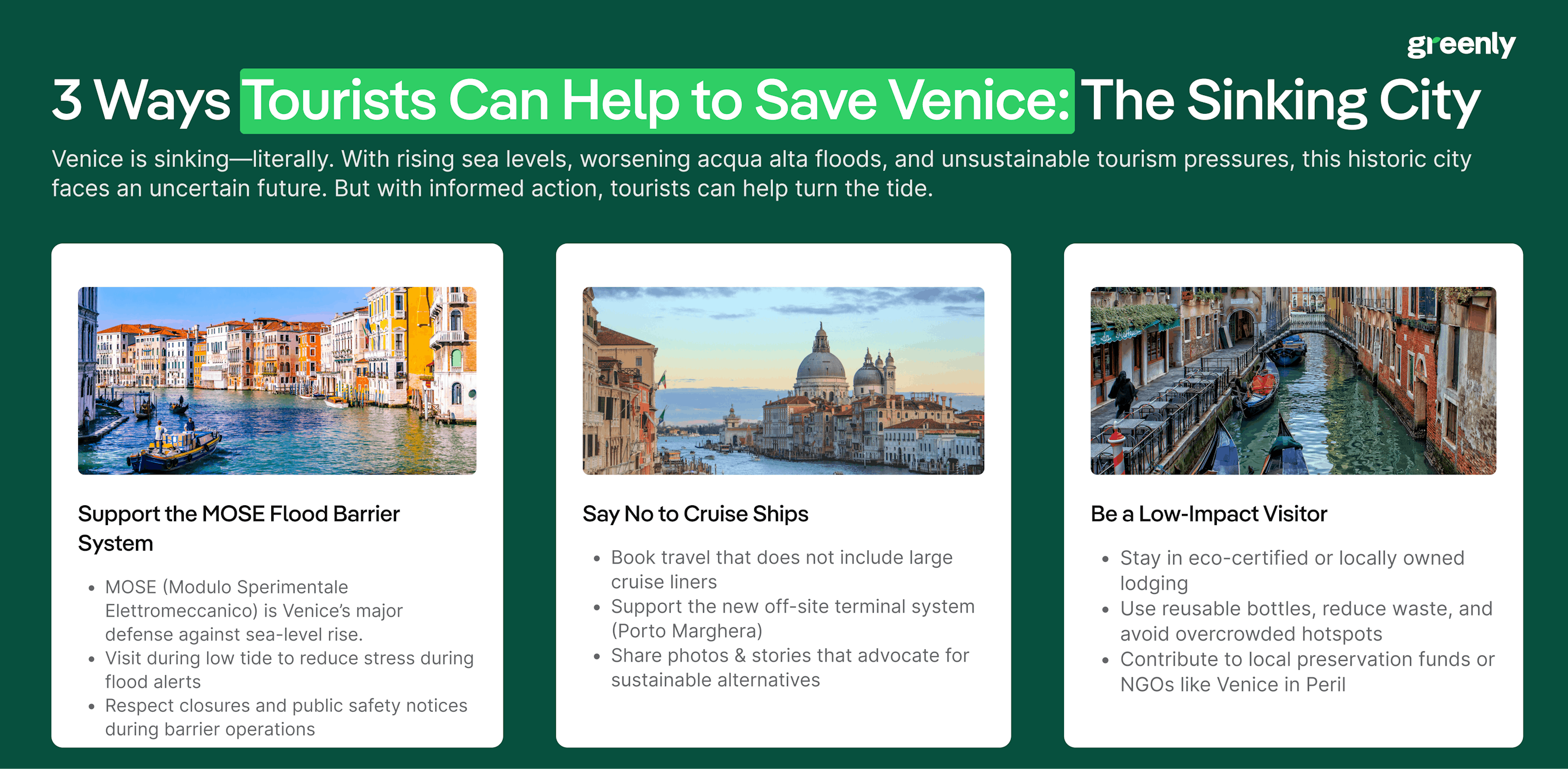

What About Greenly?
If reading this article about Venice and how climate change might impact its tourism has made you interested in reducing your carbon emissions to further fight against climate change – Greenly can help you!
Getting ahead of the climate change crisis, like Venice should, could prove challenging, but don’t worry – Greenly is here to help. Click here to schedule a demo to see how Greenly can help you comply with all of the upcoming regulations relevant to your company.
Greenly can help you make an environmental change for the better, starting with a carbon footprint assessment to know how much carbon emissions your company produces.







